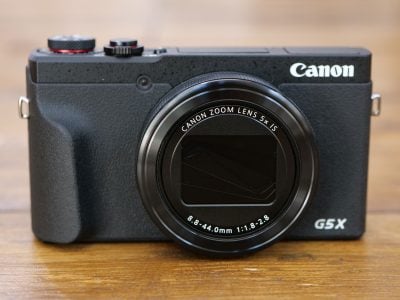Canon PowerShot G5X II review
-
-
Written by Gordon Laing
Verdict
The Canon PowerShot G5X Mark II is a powerful compact camera with a 20 Megapixel 1in sensor, 5x / 24-120mm zoom, popup viewfinder, tilting touchscreen, fast bursts and 4k video. Canon’s made a U-turn on design, swapping the chunkier DSLR-styling of its predecessor for something more pocketable and more akin to Sony’s RX100 series. So it’s out with the fixed viewfinder hump and side-hinged screen for a popup viewfinder and vertically-tilting display. The grip has shrunk and the front dial lost to make it more pocketable, but there’s still more to hold onto than the Sony RX100’s and Canon’s extended the zoom range over the original G5X model as some compensation.
The design changes do however bring it closer to the G7X III launched alongside it, with Canon essentially asking you to choose between the popup viewfinder and slightly longer (and slightly sharper) 5x zoom of the G5X versus the mic input and Live Streaming of the G7X III. Couldn’t we just have it all in one body instead, or perhaps do identical versions, with and without viewfinders to meet different price points?
Despite their similarities and shared feature-sets though, the G5X II feels like quite a different camera to the G7X III in use. I shot with both side-by-side and was struck by how useful I found having an electronic viewfinder, both for composition and playback, while the slightly longer zoom range with closer focusing at the telephoto-end gave it greater flexibility without compromising on the aperture. Annoyingly the viewfinder on the G5X II may require a two-step pop-up and pull-out mechanism which Sony’s now resolved with a one-step motion on the RX100 VI and VII, but while Canon’s approach is slower and less convenient, simply having a viewfinder remains a valuable asset over the G7X III. If you’re mostly into stills photography or don’t need the mic input and live streaming of the G7X III, the G5X II is definitely the preferred model of the two.
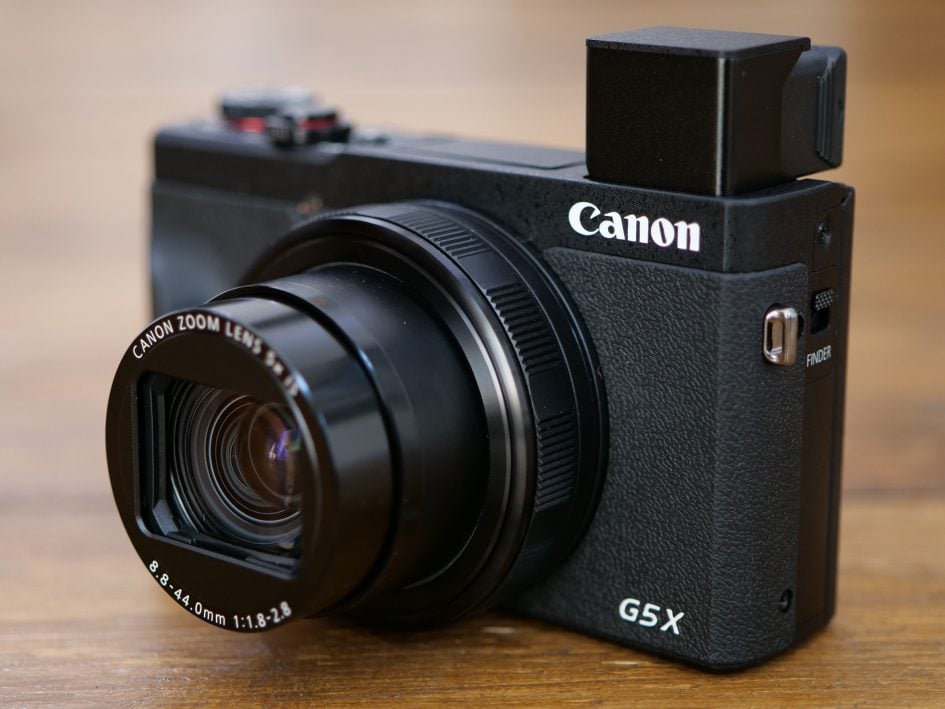
In terms of quality, the G5X II continues to employ a 1in sensor with 20 Megapixels, but Canon’s upgraded it to a stacked CMOS design that supports 4k video at 25 or 30p, 1080 slow motion up to 120p (with fixed focus and no audio), and fast burst shooting at 20fps or in a RAW-only mode at 30fps with a pre-buffering option; note both top speed modes are for Single AF only, with speeds dropping to 8fps if you want continuous AF.
Eagle-eyed camera geeks will guess the sensor is probably the same one from Sony’s older RX100 IV which means the G5X II may gain 4k and extra speed but sadly not the phase-detect AF introduced on the later RX100 Mark V, which in turn means less responsive autofocus, especially when refocusing while shooting or filming. Strangely the G5X II also loses the 24p video option (available on the Mark I) and continues to lack eye-detection too.
On the upside, the ergonomics and quality out-of-camera remain a highlight of the G5X II, with a surprisingly comfortable grip and tactile controls coupled with great-looking JPEGs and 1080 video. The new 4k video certainly records more detail than the 1080 footage, and allows clips lasting 10 minutes versus five on the RX100 models using the default settings. But Sony’s 4k footage contains finer details, and if you switch off the heat warning on the latest RX100 VII, it’ll keep recording 4k for an hour, although will become very hot to touch. In contrast, the G5X II shut itself down for cooling after recording only a clip and a half of 4k in my tests (that’s 15 minute’s worth), even though the body was barely warm to touch. Clearly Canon’s a lot more heat-averse than Sony.
The continuous autofocus and burst shooting on the Sony also remain far superior. Sure, the G5X II may now shoot at 20fps (or even 30fps in the new RAW burst mode), but both are with fixed focus. Set the camera to Servo for continuous AF and the burst speed not only drops to 8fps but you also lose face detection and are limited to a single AF frame. In contrast, the RX100 VII will shoot at 20fps with full continuous autofocus across almost the entire frame, complete with face and even eye-detection, not to mention zero blackout.
Phase detect autofocus on the Sony also means videos focus more confidently, which is invaluable whether you’re in front or behind the camera. In contrast, the continuous AF is much less responsive on the Canon, and vloggers in particular will typically need to pause for a moment for the focus to catch up with them before starting a piece to camera. Sony offers superior autofocus on the RX100 Mark VA, VI and VII, and all three are also equipped with popup viewfinders, but all are also comfortably more expensive. Even the cheapest of the three Sonys with decent autofocus, the RX100 VA, is around 10% more expensive than the G5X II and while the Sony focuses more confidently, the VA’s zoom range is much shorter than the G5X II and it doesn’t even have a touchscreen.
The bottom line is the G5X II may not be as powerful as the recent Sony’s in terms of bursts and autofocus, but its capabilities remain sufficient for most of its target audience, the images and controls look and feel better to me personally, and crucially, it’s cheaper, staying comfortably in three figures. In contrast, the top Sony RX100 VII may boast an even longer zoom, but has become sufficiently expensive for you to question whether you should buy an interchangeable lens camera instead.
Canon G5X vs G5X II
The original G5X took the 24-100mm lens and innards of the G7X II, but rehoused them in a chunkier mini-DSLR styled body with a bigger grip, viewfinder, triple control dials and a fully-articulated, side-hinged touchscreen. With the G5X Mark II though, Canon’s made a U-turn on design, with a body that more resembles the G7X series, losing the third control dial, shrinking the grip and switching to a screen that now only tilts vertically. The big differentiator remains the built-in viewfinder, but it’s now a popup design like the Sony RX100 IV, all to save space and make it more pocketable than the original G5X. Meanwhile as a sweetener for the lost features on the Mark I, Canon’s extended the zoom range from 24-100mm to 24-120mm and halved the minimum focus distance at the telephoto-end, while maintaining the maximum f1.8-2.8 aperture.
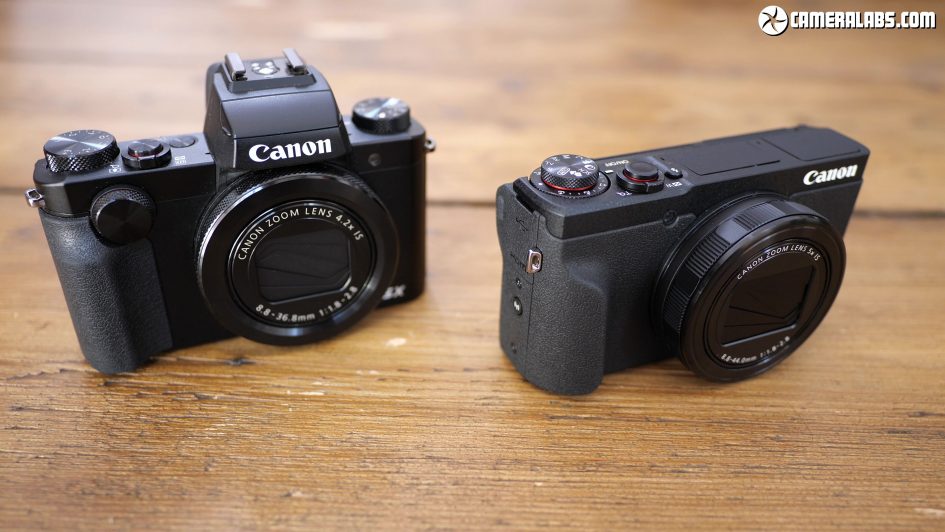
Upgrading to the G5X II over the G5X would get you a smaller body with a slightly longer zoom and closer focusing, a faster sensor with quicker bursts, 4k video and 1080p with slow motion, but again you’d lose most of the styling which probably drew owners of the original model to it in the first place, not to mention losing 24p video too. As such I don’t think many G5X Mark I owners will be making the leap. If they want a more pocketable model with greater features, they’re more likely to consider the Sony RX100 VII with its better autofocus and longer zoom, or if they still love the mini-DSLR styling, then the Canon G1X Mark III or even an EOS M50 become the ones to upgrade to.
If you don’t own a G5X Mark I, it can be worth checking prices as the original is available for around one third less than the Mark II, making it a bit of a bargain. See my Canon G5X review for more details.
Canon G5X II vs G7X III
Following an unexpected change in design, the closest rival to the G5X II has in fact become Canon’s own G7X III launched alongside it. The G5X II now shares essentially the same body design and control layout, not to mention the same photo and video quality as well as many other key features. Indeed it’s quicker to just say what makes them different: a slightly longer (and slightly sharper) 24-120mm zoom with closer focusing and a popup viewfinder on the G5X II versus the mic input and live streaming of the G7X III. You choose.
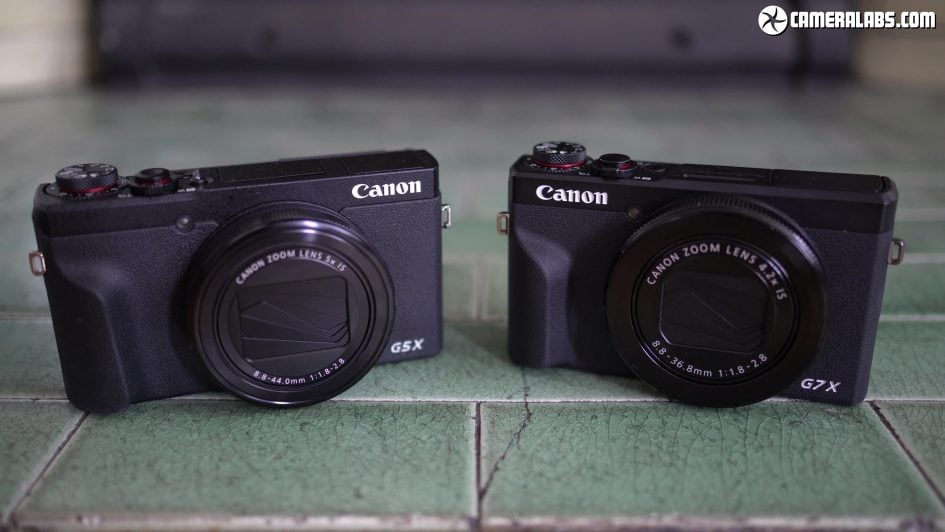
As such Canon’s clearly targeting the G7X III more to vloggers and the G5X II more as an EOS companion for still photographers, although since they both share essentially the same photo and video quality, they can both be used for the same jobs. Indeed you can’t help but wonder if it wouldn’t have been better to merge them both and have a single camera with all the new features? Of course most vloggers won’t need a viewfinder or a longer zoom and will prefer the current G7X III configuration at its lower price, but many hybrid shooters would appreciate a merged feature-set. Perhaps two version with and without a viewfinder would have been a more sensible choice?
Personally speaking as a hybrid shooter, I’d go for the G5X II and use an external sound recorder like a Zoom H1N when required, but having to choose features would also make me look towards Sony and wonder if they’d ever do an RX100 VA with a mic input. Even if they did though, I remain very fond of Canon’s output and ergonomics.
See my Canon G7X III review for more details.
Also consider the Sony RX100 VA which costs 10% more, has a shorter 24-70mm zoom and no touchscreen, but sports the confidence of phase-detect autofocus. Or if you’re attracted to Sony’s confident autofocus but want an even longer zoom than the G5X II, consider the RX100 VII which boasts a 24-200mm range, albeit with a dimmer lens aperture and an even higher price.
Canon G5X II final verdict
With the G7X III and G5X II, Canon’s delivered a pair of classy compacts which capture great-looking photos and videos with a number of useful upgrades over their predecessors – some shared such as the 4k video and fast burst shooting, while others steer them towards specific tasks. While both models deliver the same quality photos and videos, the mic input and live streaming make the G7X III more appealing to vloggers, while the viewfinder and slightly longer zoom range of the G5X II will attract stills photographers; the choice is yours.
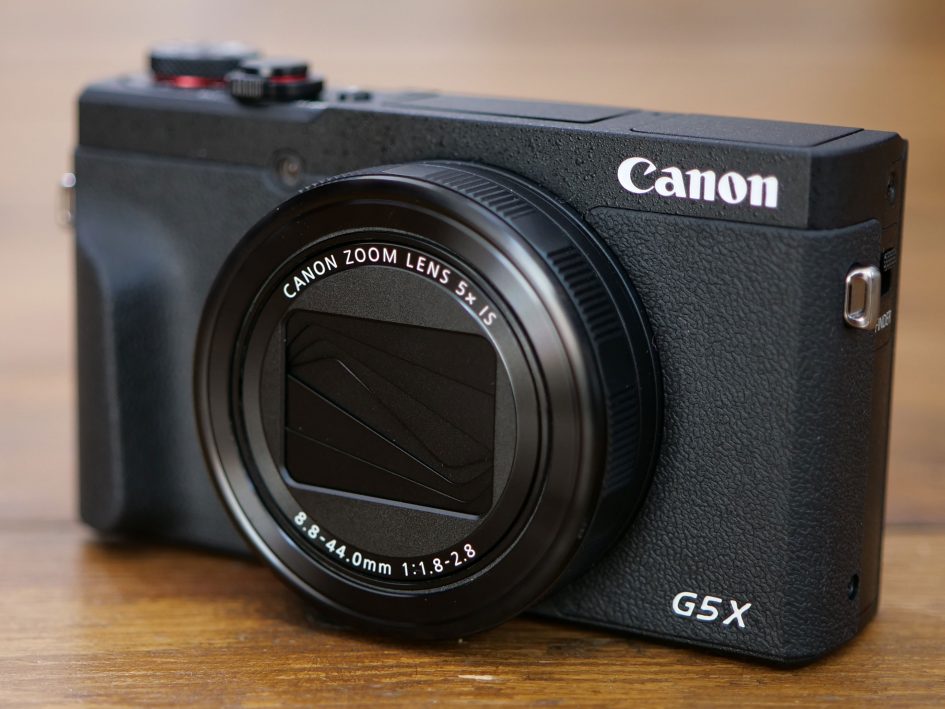
Sony’s RX100 series continues to take the lead in burst shooting and especially continuous autofocus, comfortably out-classing both Canons in these respects. It’s a shame that Canon didn’t – or couldn’t – use the newer sensor deployed in the RX100 VA onwards to enjoy the confidence of phase-detect autofocus, and it’s true that vloggers will often have to be patient and wait for the camera to catch up before starting a piece. Sony also continues to offer video at 24p when it’s mysteriously disappeared from the Canons.
But while it’s easy to criticise Canon on falling behind Sony in terms of autofocus, bursts with tracking, 4k quality or even a single-action viewfinder, it’s important to take pricing into consideration. Yes the RX100s do a great deal but of the latest three models with superior autofocus, the cheapest VA remains more expensive than the G5X II and the priciest Mark VII is comfortably into four-figures. In contrast, the two Canons are comfortably cheaper making them an easier prospect to swallow.
The G5X Mark II in particular is a very attractive small camera for general use, with a useful zoom range, close focusing, a nice bright aperture, the flexibility of a popup viewfinder or tilting touchscreen, surprisingly comfortable ergonomics for the size, and crucially great-looking photos and video out-of-camera with minimal effort. Yes, the Sony’s out-feature and out-perform it, especially in terms of autofocus and bursts, but they’re more expensive and I personally preferred the feel of the Canon and the look of its output. So while some of Canon’s decisions are undoubtedly frustrating, the G5X II overall remains a compelling camera for the money. If you don’t need the most responsive continuous autofocus, I Highly Recommend it.
Check prices on the Canon PowerShot G5X II at B&H, Adorama or WEX. Alternatively get yourself a copy of my In Camera book or treat me to a coffee! Thanks!



